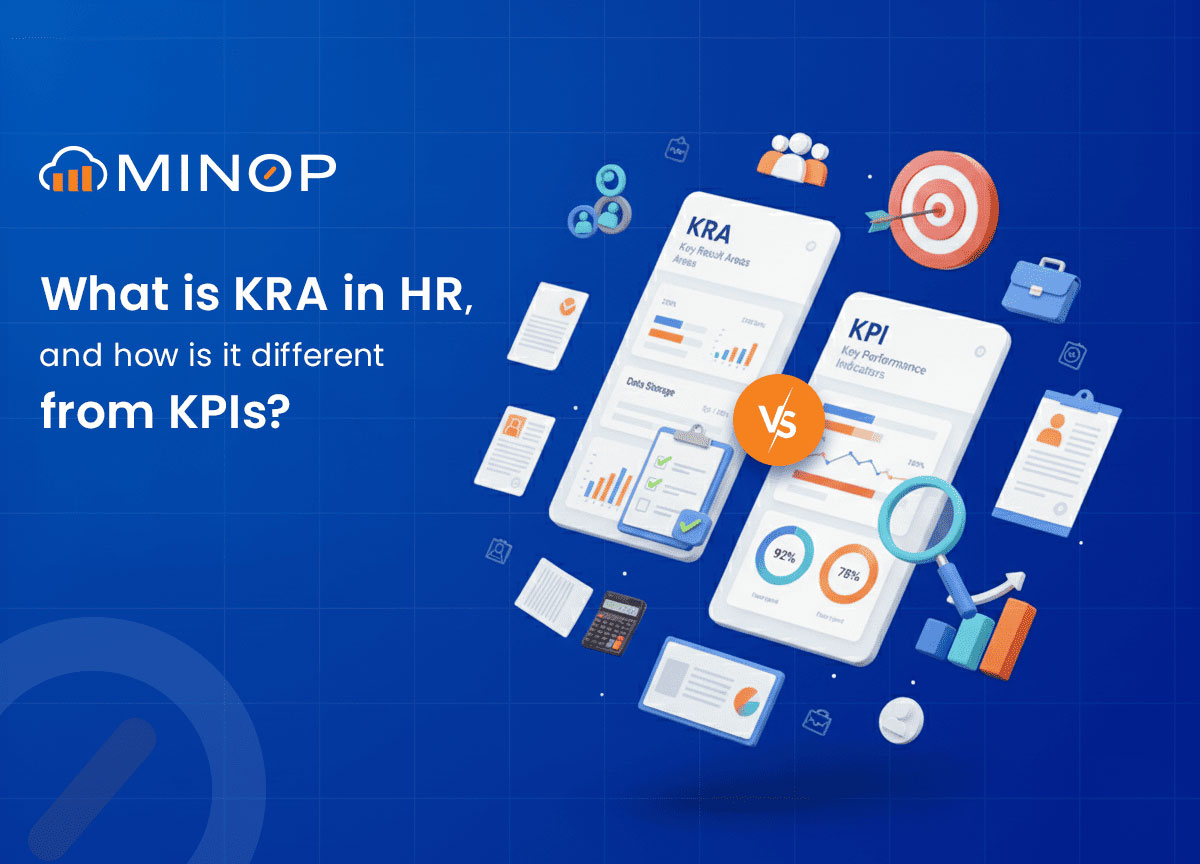What is KRA in HR, and how is it different from KPIs?
Posted On:- 16 September, 2025 By:- Vaibhav Maniyar
Introduction
Ever get that feeling? You look around, and everyone on your team is working hard, heads down, tasks getting checked off. But when you look up at the big picture, the company's main goals haven't really budged. It's a classic case of activity without impact.
This is often a sign that people aren't crystal clear on what winning actually looks like for their specific role. The solution? It's a simple but powerful tool called Key Result Areas (KRAs). This guide will break down what KRAs are, and show you how they can transform a busy team into a focused, results-driven one.
What is KRA in HR?
Definition: KRA full form in HR stands for Key Result Areas. It refers to the specific set of outcomes or responsibilities that define an employee’s main contribution to the organisation.
In simple terms, KRAs are the core areas of work where a person is expected to achieve measurable results. It’s easy for people to stay busy but not necessarily productive. KRAs bring clarity, focus, and accountability by defining what truly matters in a role by clearly stating what an employee is responsible for achieving. This removes ambiguity. Employees know exactly what outcomes they’re expected to deliver.
Furthermore, KRAs form the foundation of performance appraisals. They make it possible to measure results objectively rather than subjectively. Performance reviews become fairer and more data-driven. When employees know their KRAs, they take ownership of their results. It builds intrinsic motivation because they can see the direct impact of their work.
Example: Take a Sales Head role. A major KRA could be "Increase Company Revenue" or "Grow Market Share." Success in this area would then be measured by results such as how much sales increased or how many new markets were reached in a quarter.
Note: KRA full form in HR is Key Result Area. It's also sometimes referred to as a Key Responsibility Area. Both terms define the most important outcomes and duties of a specific job role, clarifying what an employee is accountable for achieving.
How is it different from KPIs?
This is where many people get tripped up, but the difference is actually quite simple.
A KRA is the broad, strategic outcome you're responsible for. It's the WHAT.
A KPI (Key Performance Indicator) is the specific, measurable metric you use to track your success within that KRA. It's the HOW MUCH or HOW WELL.
You can't achieve a KRA without hitting your KPIs. They work together.
Let's go back to the Sales Head example:
The KRA might be "Increase Company Revenue."
The KPIs could be "Achieve ₹2 crore in new sales per quarter" or "Maintain a pipeline three times the target quota."
So, KRAs define the main responsibility, while KPIs track the progress toward achieving it.
| Job Role | KRA | KPI |
|---|---|---|
| Sales Head | Revenue Growth | Meet new sales targets per quarter and maintain a strong sales pipeline. |
| HR Manager | Employee Retention | Reduce yearly turnover and improve employee satisfaction scores. |
| Marketing Manager | Lead Generation | Get a set number of leads each month and grow website visitors. |
| Software Developer | Code Quality | Reduce bugs and complete projects on time. |
| Customer Support Rep | Customer Satisfaction | Maintain high satisfaction scores and reduce issue resolution time. |
In short, KRA is the main goal, and KPI is how you measure whether that goal is being achieved.
Related: Everything About Payroll Structure Explained!
How to Actually Write a Great KRA in HR?
Crafting meaningful KRAs is a collaborative art, not a top-down command. It's about connecting an individual's purpose to the company's vision. Here's how you do it.
Step
Start with the "Why"
Before you write a single word, zoom out. What are the company's biggest goals this year? What is this team's primary mission? Every KRA must directly support those higher-level objectives. Ask yourself: If this role nails its KRAs, will the company be in a significantly better place? If the answer is no, you're focused on the wrong things.
Step
Make it a Conversation, Not a Memo
The most effective KRAs are born from discussion. You absolutely need to sit down with the employee. A manager brings the strategic perspective ("Here's where the company is going"), while the employee brings the on-the-ground reality ("Here's what's achievable and what I can directly influence"). This dialogue builds ownership. When people help set their own goals, they are far more motivated to hit them.

Step
Write with Action and Clarity
Now, let's put pen to paper. Use strong, action-oriented language. Don't be vague.
Instead of: "Responsible for sales."
Try: "Drive New Business Revenue Growth."
Instead of: "Product Management."
Try: "Successfully Shepherd Products from Concept to Market Launch."
This simple shift in language frames the work around results, not just duties.
Step
Immediately Connect Each KRA to SMART KPIs
A KRA without a way to measure it is just a nice idea. Once you've defined a KRA, immediately ask, "And how will we know we've achieved it?" This is where you link it to SMART KPIs (Specific, Measurable, Achievable, Relevant, Time-bound).
Related: The Ultimate Leave Letter Guide for Every Situation
4 Common KRA Mistakes and How to Fix Them
Setting KRAs seems easy, but a few common mistakes can make them totally ineffective. Here are the big ones to watch out for.
Measuring Effort Instead of Impact
This is when you mistake activity for results. A KRA like "Make 100 cold calls a day" is about activity. A better KRA is "Expand the Sales Pipeline," measured by the KPI "Generate 10 qualified leads per week." Always focus on the outcome, not just the hustle.
Creating Too Many Priorities
An employee with 10 KRAs has zero KRAs. Their focus is completely shattered. Stick to the vital few — usually 3 to 5 core areas are perfect. This forces a real conversation about what truly drives success in that role.
Treating KRAs as a One-Time Task
You should review KRAs annually or whenever a role significantly changes. The KPIs that measure them? Those need to be checked in on far more often, like monthly or quarterly, to make sure you're on track.
Assigning Goals Outside an Employee's Control
It is incredibly demotivating to be held accountable for something you can't influence. For example, giving a junior marketer a KRA for "Increase Company Profitability" is unfair. Their work contributes, but they don't control pricing or operating costs. Make sure the KRAs and their KPIs are within the employee's sphere of influence.
Lastly, Tracking KRAs in spreadsheets or long email chains wastes time and leads to confusion.
Use simple cloud-based tools or HR software that keeps everything in one place. It saves time, reduces errors, and makes performance tracking easier for everyone.
Final Thoughts
Peter Drucker once said, "What gets measured gets managed." When you get this right, performance reviews stop being dreaded, box-checking exercises. They become energizing conversations about real impact and growth. You build a culture where everyone knows what the goal is and can see exactly how their work is helping to win the game.
FAQs
How many KRAs should an employee have?
Usually, 3 to 5 is ideal. Too many can make it hard to focus on what's most important.
Who sets KRAs and KPIs?
Both the manager and employee should work together. Managers set direction, and employees share what's realistic.
How often should they be reviewed?
KRAs once a year (or when the role changes). KPIs more often — monthly or quarterly.
What's the main difference between a KRA and a KPI?
KRAs show what needs to be achieved. KPIs show how well it's being achieved.
What is the KRA full form in HR?
KRA full form in HR is, "Key Result Area".

Comments